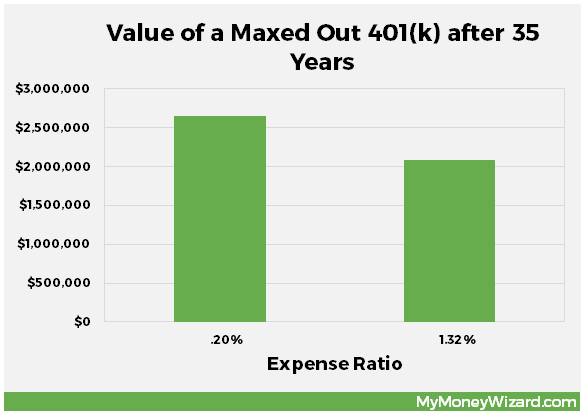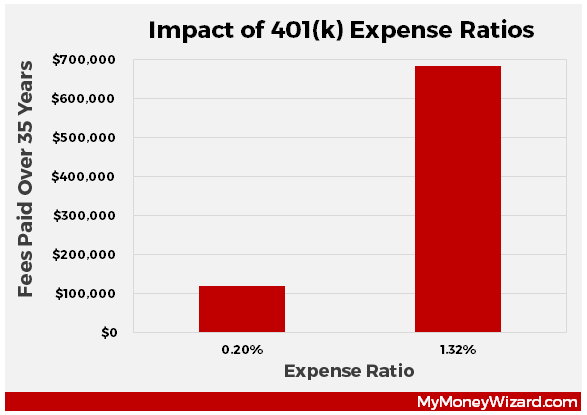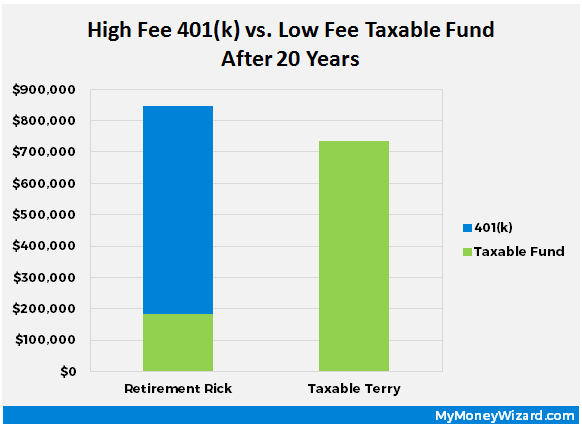
We all agree there’s no easier way to become a millionaire than steadily investing into your 401K, right? After all, a new grad maxing out her 401K every year is all but guaranteed to retire with about $4 million dollars.
Say, you’d like $4 million! (Me too!)
So you go job hunting, survive the ringer of the interview process, and eagerly accept your new dream job. You’re excited, because you’ve found a gig in a great part of town, with exciting opportunities, and job responsibilities that perfectly align with your moral code and life passions.
…Either that, or the pay was too good to say no.
In any case, you show up on the first day, meet your friendly, smiling coworkers for the first time, and get a tour of your new home away from home. At some point, HR hands you a mountain of papers to sign, including some bit about the company 401k.
You thumb through their gigantic retirement packet, admiring the awkward stock photography on every other page. You’ve never seen so many suit wearing professionals floating against white backgrounds in your entire life. And why are they all grinning ear to ear while doing incredibly mundane tasks?
Never mind that confusion, you notice something that catches your eye. Buried among paragraphs of retirement advice that couldn’t be more boring if it tried, you see the company’s 401k’s fund options.
Excited, you scan for low fee Vanguard funds, since you’ve seen The Money Wizard type endlessly about their greatness.
That’s weird… no Vanguard funds.
You continue scanning the page, before coming to a disappointing conclusion about your new dream job’s 401k options:
They all suck.
What to do?
Should you ditch the 401K? Is it smarter to instead invest in an IRA, or even a low fee, taxable account instead?
1. Comparing Average 401k Expense Ratio and Statistics
First off, let’s determine whether your gut feeling of 401k suckage is actually true.
It very well may be – this high cost 401k dilemma is more common than you think. Unfortunately, your new coworkers aren’t likely to be much help on the subject matter.
Far from maxing out their tax benefits, the average employee:
- Contributes just 7% to their 401k
- 40% of employees have less than $10,000 in their retirement plans
- And a full 20% ignore this huge benefit all together.
But not you, you’re a Money Wizard reader. You’re all about maxing out these savings cheat codes and building as much wealth as possible. So let’s see just how your company’s 401k plan is stacking up against the average.
According to the Center for American Progress (no clue who that is either, but their sources check out):
- The average 401k expense ratio is 1% of assets managed.
- Small businesses (less than 100 employees) have an average 401k expense ratio of 1.32%.
At first glance, a 1% expense ratio doesn’t sound too bad.
Wrong! The same study showed a 1% expense ratio costs the average american $138,336 over their lifetime!
2. Fees Matter
Big time. And fees matter even more when you’re an above average saver.
Let’s consider two new grads savers. One new grad maxes out their 401k while working for a small business whose retirement program only offers funds with a 1.32% expense ratio. The other new grad also maxes out their 401k, except their employer’s 401k offers a Vanguard fund with a 0.20% expense ratio.
We’ll assume both continue maxing out their 401ks over their 35 year careers, and the market returns 7%. We’ll assume they both make $50,000 and get a 4% employer match.


Just a 1.12% difference in expense ratio cost our saver $564,00! The difference between retiring with $2.65 million and $2.08 million.
(Btw – If you’re curious, the average employer match is 3.5% of the employee’s salary, according to the Bureau of Labor Statistics. Anecdotally, the average office worker I know gets a match of 4-5%.)
3. Make Sure Those High Expense Ratios Are Actually High
The good news is the 1% average ratio is just that – an average. Most 401k plans have upwards of 10-20 different mutual funds to choose from. Looking through the mutual fund list often looks something like this:
- Option A: Some ridiculously named actively managed fund – 2.00% expense ratio.
- Option B: Another ridiculously named actively managed fund – 1.50% expense ratio
- …
- Option Z: Reasonable Vanguard Index Fund – 0.15% expense ratio.
Choose your 401k investments carefully! In 3 minutes I saved my brother $210,000 in lifetime investment fees, just by switching his 401k to a lower cost index fund. Take that, Geico!
*In researching this article I found many disturbing instances where companies such as Fidelity and basically anyone not named Vanguard were sneakily charging fees on top of the Expense Ratio. Beware of: management fees, distribution/service/12b-1 fees, sales charges, or anything else that sounds like a fee. Yet another reason I default to Vanguard.
So, What If My 401k Still Sucks?
There are times when a 401k has no good options. If you’ve ran the numbers and determined that your 401k does in fact suck, should you look to invest elsewhere?
Standard operating procedure around here suggests the ideal wealth building plan is:
- Contribute up to the IRS allowed 401k max ($18,000 per year)
- Contribute up to the IRS allowed IRA max. Preferably in a Roth, assuming your 401k is traditional. ($5,500 per year)
- Contribute anything leftover to after-tax, low fee index funds, such as Vanguard. (As much as possible)
If you’ve established that your 401K sucks, you might be temped to shift up the order of operations to instead:
- Contribute up to the IRS allowed IRA max ($5,500)
- Contribute to an after-tax, low fee index fund, like Vanguard.
- Maybe contribute enough to get the company match from your 401K, while you curse your employer for having a retirement account with such high fees.
It’s a reasonable conclusion, but taking this approach would be a HUGE MISTAKE for most investors!
Even a Bad 401k Is Usually Better than a Taxable Index Fund
I love Vanguard, and I love low fee index funds. I’ve written about the beauty of both several times.
However, when push comes to shove, the two can rarely compete with even the worst of 401Ks. Why? Three reasons:
1. The employer match is literally free money: Some companies provide matches up to 100% of a portion of your 401k contribution. If so, this match is the only investment in the world which provides a 100% return, guaranteed.
I don’t care what fees your 401k is charging. If it means your employer is handing you a couple thousand dollars for free every single year, they’re worth it.

2. You may not stay with the company forever: If you ever leave your company for any reason, you can always roll-over your high fee 401k into a low-fee traditional IRA, at no cost to you.
In other words, high 401k fees are only temporary, while the tax benefits of a 401k are forever. Take advantage while you can, because once the tax year is up, you can never go back!
3. Those tax Advantages are huge! In a traditional 401k, you defer paying taxes on your 401k contributions for decades. By the time you eventually withdraw money from your retirement account, you’ll hardly notice the blip in taxes from your mountainside beach house.
Maxing out my own 401k every year reduces my taxable income by $18,000 and reduces my tax bill nearly $6,000. That’s an extra $6,000 I get every year, which can be invested and grown into a larger and larger sum.
Plus, like almost all of the population, I will probably retire into a much lower tax bracket than during my working days. The lower tax rate directly converts those tax deferrals into tax savings.
Meanwhile, even the best low fee index fund outside of a 401k gets hit hard by taxes. In a taxable index fund:
- Your money is taxed before you ever get to invest it (25% for most Americans).
- Then you pay taxes every year on the fund’s dividends.
- You continue to pay those dividend taxes even if you leave your employer.
- Then you ultimately pay capital gains taxes when you sell the fund in retirement.
How much does this all add up to?
A lot! Usually far more than even a high fee 401k.
Let’s compare someone paying a 1% expense ratio in a 401k versus someone who chooses to invest into the lowest fee, taxable index fund around – a Vanguard fund with a 0.05% expense ratio.
We’ll assume the market returns 7% over their 20 years at the company.
Retirement Rick invests in a 1% expense ratio 401k. Taxable Terry invests in a .05% expense ratio taxable Vanguard fund.
| Retirement Rick | Taxable Terry | |
| Salary | $ 70,000 | $ 70,000 |
| Contribution | $ 18,000 | $ 18,000 |
| Taxable Income | $ 52,000 | $ 70,000 |
| Taxes Owed | $ 7,196 | $ 11,696 |
| Extra to Invest | $ 4,500 | $ 0 |
| Total Invested Each Year | $ 22,500 | $ 18,000 |
| Account Balance after 20 years | $ 845,615 | $ 733,902 |
In the above example, because Retirement Rick contributed to a 401k, he reduced his taxable income by $18,000 per year. This reduced his tax bill, which left him an extra $4,500 in his pocket to invest outside of his 401k, every single year!
So while Taxable Terry could only invest $18,000 into a taxable Vanguard fund, Retirement Rick could invest $18,000 in his 401k, plus $4,500 into the same taxable Vanguard fund, for a total of $22,500 invested each year.
By the end of his 20-year career, Retirement Rick had $845,615:
- $662,140 in his 401k
- $183,475 in his taxable account

At the end of Taxable Terry’s 20-year career, his taxable account (even with a lower fee) had $112,000 less.
In this scenario, Retirement Rick’s 401k could have fees as high as 2.19%, and he’d still end with more money!
Plus, after their 20-year career at the company ended, Rick could then simply roll over his 401k into a low fee, Traditional IRA at Vanguard. He’d now have the same expense ratio as Terry moving forward, plus the benefit of 20 years of tax free growth (which gave him an extra $112,000!)
The High Fee 401k Game Plan
Even with expense ratios above 2%, the 401k still wins. So when you’re back staring at your high fee 401k fund and have finished cursing your employer, here’s what to do.
- Look through the 401k’s list of funds. Even bad 401k plans typically have one or two lower fee index funds.
- If your company provides any sort of matching, definitely contribute up to the company match.
- If even the lowest fee 401k funds are less than 2% or so, continue to contribute up to the IRS allowed maximum in your 401k. ($18,000 as of 2017)
- Contemplate how much you like your job, and consider switching to an employer with a good 401k plan. 🙂
(I’m assuming you’re saving enough to max out both your 401k ($18,000) and your IRA ($5,500). If not, consider a more frugal lifestyle, and in the meantime, it’s okay to prioritize a low fee IRA over the high fee 401k, AFTER you’ve received the company match.)
Does your employer offer a good 401k option? If not, what’s your strategy?
Related Articles:


I would include the option of going to talk to HR and ask that some lower-cost fees be included.
I worked as the Controller/HR at my last company and I was in charge of the 401(k) plans. If an employee had cared enough to come ask me to consider adding some funds for a particular goal, I would definitely have heard him/her out. As long as I didn’t think the fund would be poorly suited for the employee group as a whole (like the volatile sector funds I axed), I would probably add it.
But we already had low-cost Vanguard index funds, so really, what else could anyone need or want? 🙂
Also, some 401(k) plans do have distribution fees, even for rollovers. When I left that employer, I had a $50 distribution fee deducted from my balance per the plan document.
Great point about talking to HR, Karl. Don’t forget that somewhere, there IS a human in charge of selecting the funds. If you’re concerned, voice it!
Thanks for clarifying the distribution fees. $50 is definitely worth it to switch to lower expenses for life.
I am a Canadian and have what is called a defined contribution pension plan, which is similar to a 401k. In Canada combined pension plans and RRSPs (equivalent of IRAs), can go to the max of 18% of salary to a max of 24,000/year, whichever is lower.
My company is extremely generous and does 5% contribution automatically, and then matches up to 5% if i put in 5%. This is a total of 15% contributed every month and i am only putting in 5%. I then top up the additional 3% in my external RRSP for a full contribution of my tax deferred retirement accounts. I also max my 5,500/year TFSA (think Roth) which is separate and additional to the above accounts.
My fund options are pretty decent for Canada (we have the highest fees in the world). I pay an MER of 0.2% for a S&P 500 fund, 0.325% for a MSCI EAFE fund (international developed), 0.2% for a bond index, and .5 for a Canadian value fund (they didn’t have any index options). It works out to a weighted average expense ratio of about 0.35% which isn’t too bad. Most Canadians pay about 1.8% which is insane.
I should talk to our HR people about getting a low cost Canadian index in there and i would be all set.
Sounds like a good plan at your employer! That company matching amount is insane.
I have never heard of an amount that high either from any other company.
Me neither. 9% is the highest I’ve ever heard of here in the States, and even that’s only mentioned in whispers like some sort of urban legend.
We, employees of the University of Michigan, have exactly the same benefits as Dan has. UofM contributes 2 times more (up to %5) on top of my contribution which is lovable 😉
For employees, 401k is probably the best option to reduce taxable income. Now, if you are looking for options outside your 401k, invest in Vanguard for their very low fees. If you have $10K to invest, go for the admiral funds. Those have ridiculously low fees (0.0x%) compared to the ‘investor’ version of the same funds. No, I don’t work for Vanguard.
At what point though is sucky, just sucky?
I looked up my companies 401(K) score on Brightscope and they came in with a rating of 48 (brightscope gives input saying I’d have to work an extra 18 years, and would still be short.~$250K compared to someone with a better/average rated 401k plan). I can also see the total fees paid on the portfolio, and that the portfolio lost close to $90K within the 2015 fiscal year. When I started just under a year ago at the company, there was no match, and as of January 1st it is now 60 cents on the dollar, up to 5%, with the following vesting schedule:
after first year-0%
after 2nd-20%
after 3rd-40%
after 4th-60%
after 5th-80%
after 6th-100%
I have not enrolled in my employers 401(K) plan, and with my current financial situation, my approach has been the following (as of right now I am in a lower tax bracket than I know I will be in later on in my engineering career):
-Putting ~$1k a month towards student loans (plan is to knock this out in just under 3 years)
-Max out my Roth IRA (going strong on 2 years…1st year opened the account with the $5,500 max, this is my 2nd year and doing $450/month +$100)
-Invest anything from $100-200 a month in my traditional brokerage account
-Staying a little cash heavy and using Ally for their 1% interest savings account
I’m 25, and due to recent unforeseeable changes at my work, actively looking to move-on from where I’m at. I’m definitely not against 401(K)’s and would actually prefer settling some place to take advantage of one, but at this time in my life and with the limited sucky options available, not really seeing any upside to seeing someone else lose my money (I’ve talked to some of the other 20+ year employee’s and the losing of retirement account portfolios sounds like the norm -_-. how is that even acceptable?)
Three questions for you Steph:
1) What are the fund options for your 401k? The types of funds, and what they invest in, will give you more information than whether a specific fund made or lost money in one year. And depending on the size of the total fund, losing $90k might sound a lot worse than say, a half a percent loss in one year. One year of returns is a blip in the investing time frame.
2) What are the expense ratios for those funds? Total fees paid on a massive company wide portfolio doesn’t provide as clear of a cost as the individual expense ratio. In general, any expense ratio under 2% is usually worth participating in.
3) Reason that you’re staying cash heavy? The tax advantages alone from a 401k will stomp Ally’s 1% interest.
Out of 40 fund options, 20 individual funds are under 1% ER…most hovering between .8-.97%. the lowest fund option is a Conservative Money Market at .66%, and only one Vanguard Small Caps fund is at .69%
Through the Brightscope rating/details, that $90K was lost on the total company fund which is hovering around $2 million (company is ~70 eligible employees, plus a bunch ~70-80 of ineligible staffing employees throughout the factory).
I dug a little deeper and saw the the “automatic” option is setup to go into a conservative, high ER fund. I talk to a lot of the 20+ year employees who say they never seem to see their money grow…so this is probably the reason, also it’s blatantly obvious there is a lack of communication as to what all the options are from HR, because the older employees didn’t even know they could login to see their accounts and only saw the quarterly paper statements. I’ve asked a few questions, and could see HR’s tone getting defensive, and they couldn’t answer any of the questions I had.
Update as of 4/25
HR actually came to our offices to inform us that there will be a transition from the current John Hancock 401k plan to our new owners’ Prudential 401k. A Prudential rep will be doing 4 presentations throughout the day next Tues, 5/2, to go over plans available.
Perfect opportunity to get questions answered. Is there anything you think I should specifically ask?
I’d ask if any of the fund options are passively managed indexes intended to track the S&P 500 or broad stock market index, and what their expense ratios are. Also wouldn’t hurt to reread item #3 in the article above, and confirm with the rep whether those funds charge any fees in addition to the listed expense ratio.
Remember, even a 1 to 2% expense ratio in a 401k is usually better than a 0.05% expense ratio is a taxable fund.
I’ve had bad 401K’s and great ones – and all of them now sit in a low fee IRA. If you were to stay a really long time at an employer with a high-fee one, that might take its toll, but it also would represent some sort of natural hedge (steady employment and likely advancements / promotions).
One thing to consider when leaving a company with a high-fee 401K – definitely explore if a new employer’s 401K (if it’s a good one) accepts rollovers. Establishing an IRA with a fat balance can complicate backdoor Roth IRA strategies down the road.
Thanks sharing the wisdom Paul!
Your articles are always so informative! Loved the comparison between a .20% fee and 1% fee.
Honestly, this article should be attached to the mountain of paperwork on the first day of a new job hahaha.
Everyone, talk to your HR about including a printout of the archives with new employee orientation! Haha!
Good point about the likely temporariness of a bad 401k. Considering the fact that most of us youngins are probably not staying in the same job for 30 years, it’s easy enough to snag those tax savings now, then roll it over to a better account later on. I suspect that most people who say that their 401ks aren’t worth investing in are making excuses to just not save money.
Very possible. Kind of like going avoiding the gym… it doesn’t take much for people to bail on retirement savings.
On average my employers plan is horrid. The average is pushing 2 percent. But it does contain 2 nice Vanguard index funds. My 401k cash goes solely in these funds and the rest of my accounts maintain my allocation. It really is sad how bad some plans are.
Hey, all it takes is one or two good funds!
Hi, Love your comparison but I have been racking my brain trying to figure out the formula used for the TAXES OWED line between Retirement Rick & Taxable Terry. Can you shed some light on this? Sorry for the silly question 🙂 Thanks!
My company does not match and the fees seem high to me. Specifically I’m looking at American Funds Target Date 2045, which has 1.22 expense ratio, but also seems to include a 5% front load and 1% back load. Knowing that there is no match and taking into account the front and back loads, is it still worth the investment? Or should I invest in low fee Vanguard funds? Thanks.
Very informative read! I’m just starting a new job with high 401k fees (below 2% though) and I’m wondering how your study would look now, with the new tax laws? Now that most people are being taxed less, are 401k contributions still as compelling?
Retirement Rick still owes income tax on the $662,140 in his 401k. Taxable Terry doesn’t owe any income tax on his savings.
Terry would owe long term capital gains taxes on all $733K, which is usually 15%. Rick still comes out ahead. Plus he’s got lots of options to minimize the income taxes owed.
Terry wouldn’t own LT Capital Gain on all of his $733k only on earnings ($733k -$360k) and if he harvested the gains he may not owe any tax. + he isn’t held hostage by the 401k shackles. Rick likely come out ahead but but he owes ordinary income tax on all $663k which could be an ever larger effective tax rate.
https://wealthyaccountant.com/2019/03/31/when-adding-to-your-retirement-plan-is-a-bad-idea/